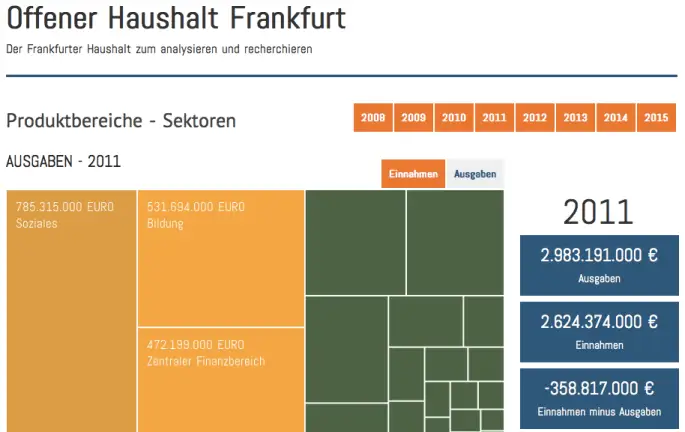Budget transparency: A few clicks to accountability?

Frankfurt budget vizualization
".. if you don’t adapt your way of presenting to the way that people understand it, then you won’t get it through. You must prepare the food in a way that makes people want to eat it. The dream that you will train the entire population to about one semester of statistics in university: that’s wrong." Hans Rosling about the importance of good data presentation.
Budget transparency websites such as openspending.org are lately criticized that opening and vizualizing data is not enough. Journalists are required to find the stories behind such data as David Sasaki argues in his interesting post.
First, raw data is not enough — we need visualizations to understand it. Second, visualizations are not enough — we need journalists to investigate and tell stories about the data.
I agree it is essential that secrets or wrong spendings need to be disclosed by journalists, but accountability can work also in different ways. One of the biggest challenge at the moment is the lack of simple information services. For example take the OECD website aidflows.org. The website has a loading time of almost a minute and then offers data for scientist but not for a person, who wants quick access to data.
Good transparency means to me that I need maximum 2-3 clicks or 30 seconds to find a specific budget item. It means a journalist can get the exact numbers during a press conference. It sounds trivial, but the majority of data website lack these features and are often too complicated.
A while ago I received the budget for the municipality of Frankfurt, Germany. Nice raw, clean data with all revenues and expenditures for the last four years. Inspired by Openspendings.org I forked the software to vizualize the budget of Frankfurt. You can now easily browse from large to small budget items and analyze financial flows. Unfortunately some categorizations for budgets are still confusing, but instead of looking through 2874 PDF pages, you can now access the budget within a few clicks. That does not disclose any wrong spendings of the administration, but it makes financial data easily understandable and accessible.
„The problem with fiscal transparency portals is that there is no mechanism to oblige government agencies to defend the purchases they make, much less sanction them when they mis-spend public funds.“ David Sasaki
David Sasaki gives a great example from Mexico, how such disclosed data can also have no implications. However, in my opinion such portals are already a great step towards transparency, because they reduce search costs. We are just at the beginning of fiscal transparency. Soon we will hopefully have easy mobile access and location-based spendings.
At the moment we only scratch at the surface, present mostly aggregated data and experiment still a lot to find best ways to present data. Hopefully soon we have more fine granular data and better ways to make data even better accessible for quick analysis in different contexts.